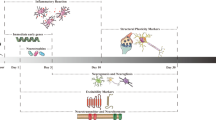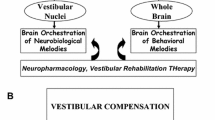Abstract
Over the last few decades, several studies have been conducted to identify the mechanisms involved in spontaneous functional recovery following peripheral vestibular damage. Different reactive processes occur at both the central and peripheral levels over the first few hours after the loss of the peripheral vestibular input. The restoration of the electrophysiological homeostasis between opposite vestibular nuclei is one of the key mechanisms of central compensation. This is achieved through a mosaic of biochemical events within the vestibular nuclei that each occur with their own kinetics. At the same time, under specific conditions, strong synaptic plasticity may take place within the vestibular sensory organs. It is thought that this reactive plasticity can contribute to the repair of damaged contacts between hair cells and fibres of the vestibular nerve, thus gradually restoring peripheral sensory input. These different plastic phenomena seem to reproduce those observed during development. Research is now needed to identify the cellular and molecular mechanisms that support this spontaneous peripheral repair process, with the ambition 1 day to be able to control it and stimulate the restoration of gait and balance.
Similar content being viewed by others
References
Ris L, de Waele C, Serafin M, Vidal PP, Godaux E (1995) Neuronal activity in the ipsilateral vestibular nucleus following unilateral labyrinthectomy in the alert guinea pig. J Neurophysiol 74(5):2087–2099. https://doi.org/10.1152/jn.1995.74.5.2087
Smith PF, Curthoys IS (1989) Mechanisms of recovery following unilateral labyrinthectomy: a review. Brain Res Brain Res Rev 14:155–180
Dutia MB (2010) Mechanisms of vestibular compensation: recent advances. Curr Opin Otolaryngol Head Neck Surg 18:420–424 (Review)
Straka H, Vibert N, Vidal PP, Moore LE, Dutia MB (2005) Intrinsic membrane properties of vertebrate vestibular neurons: function, development and plasticity. Prog Neurobiol 76(6):349–392
Beraneck M, Idoux E (2012) Reconsidering the role of neuronal intrinsic properties and neuromodulation in vestibular homeostasis. Front Neurol 28(3):25. https://doi.org/10.3389/fneur.2012.00025 (eCollection 2012)
Smith PF, Darlington CL (1991) Neurochemical mechanisms of recovery from peripheral vestibular lesions (vestibular compensation). Brain Res Rev 17:183. https://doi.org/10.1016/0165-0173(91)90001-O
Dieringer N (1995) Vestibular compensation: neural plasticity and its relations to functional recovery after labyrinthine lesions in frogs and other vertebrates. Prog Neurobiol 46(2–3):97–129. https://doi.org/10.1016/0301-0082(95)80009-w (Review)
Curthoys IS, Halmagyi GM (1995) Vestibular compensation: a review of the oculomotor, neural and clinical consequences of unilateral vestibular loss. J Vestib Res 5:67–107
Vidal PP, de Waele C, Vibert N, Mühlethaler M (1998) Vestibular compensation revisited. Otolaryngol Head Neck Surg 119(1):34–42
Darlington CL, Smith PF (2000) Molecular mechanisms of recovery from vestibular damage in mammals: recent advances. Prog Neurobiol 62:313–325 (Review)
Curthoys IS (2000) Vestibular compensation and substitution. Curr Opin Neurol 13(1):27–30
Dutheil S, Watabe I, Sadlaoud K, Tonetto A, Tighilet B (2016) BDNF signaling promotes vestibular compensation by increasing neurogenesis and remodeling the expression of potassium-chloride cotransporter KCC2 and GABAA receptor in the vestibular nuclei. J Neurosci 36(23):6199–6212. https://doi.org/10.1523/JNEUROSCI.0945-16.2016
Tighilet B, Leonard J, Mourre C, Chabbert C (2019) Apamin treatment accelerates equilibrium recovery and gaze stabilization in unilateral vestibular neurectomized cats: cellular and behavioral aspects. Neuropharmacology 144:133–142
Lacour M, Tighilet B (2010) Plastic events in the vestibular nuclei during vestibular compensation: the brain orchestration of a “deafferentation” code. Restor Neurol Neurosci 28(1):19–35. https://doi.org/10.3233/RNN-2010-0509
De Waele C, Campos Torres A, Josset P, Vidal PP (1996) Evidence for reactive astrocytes in rat vestibular and cochlear nuclei following unilateral inner ear lesion. Eur J Neurosci 8:2006–2018
Campos Torres A, Vidal PP, de Waele C (1999) Evidence for a microglial reaction within the vestibular and cochlear nuclei following inner ear lesion in the rat. Neuroscience 92:1475–1490
Dutheil S, Brezun JM, Leonard J, Lacour M, Tighilet B (2009) Neurogenesis and astrogenesis contribute to vestibular compensation in the neurectomized adult cat: cellular and behavioral evidence. Neuroscience 164:1444–1456
Dutheil S, Lacour M, Tighilet B (2011) Neurogenic potential of the vestibular nuclei and behavioural recovery time course in the adult cat are governed by the nature of the vestibular damage. PLoS One 6(8):e22262
Liberge M, Manrique C, Bernard-Demanze L, Lacour M (2010) Changes in TNFa, NFkB and MnSOD protein in the vestibular nuclei after unilateral vestibular deafferentation. J Neuroinflamm 7:91
Tighilet B, Brezun JM, Dit Duflo Sylvie G, Gaubert C, Lacour M (2007) New neurons in the vestibular nuclei complex after unilateral vestibular neurectomy in the adult cat: reactive neurogenesis in adult vestibular lesioned cats. Eur J Neurosci 25(1):47–58. https://doi.org/10.1111/j.1460-9568.2006.05267.x
Tighilet B, Chabbert C (2019) Adult neurogenesis promotes balance recovery after vestibular loss. Prog Neurobiol. https://doi.org/10.1016/j.pneurobio.2019.01.001
Lacour M, Helmchen C, Vidal PP (2016) Vestibular compensation: the neuro-otologist’s best friend. J Neurol 263(1):54–64
Chabbert C (2009) Cellular effects of alterations of gravity on mammal vestibular endorgans. In: Monici M, Van Loon JJWA (eds) Cell mechanochemistry. Biological systems and factors inducing mechanical stress, such as light pressure and gravity. Transworld Research Network, Kerala. ISBN: 978-81-7895-458-5
Bianchi LM, Conover JC, Fritzsch B, DeChiara T, Lindsay RM, Yancopoulos GD (1996) Degeneration of vestibular neurons in late embryogenesis of both heterozygous and homozygous BDNF null mutant mice. Development 122(6):1965–1973
Chabbert C, Mechaly I, Sieso V et al (2003) Voltage-gated Na+ channel activation induces both action potentials in utricular hair cells and brain-derived neurotrophic factor release in the rat utricle during a restricted period of development. J Physiol 553(1):113–123. https://doi.org/10.1113/jphysiol.2003.043034
Favre D, Sans A (1979) Morphological changes in afferent vestibular hair cell synapses during the postnatal development of the cat. J Neurocytol 8(6):765–775
Bruce LL, Fritzsch B (1997) The development of vestibular connections in rat embryos in microgravity. J Gravit Physiol 4(2):59–62
Brugeaud A, Gaboyard-Niay S, Puel J-L, Chabbert C (2006) Development under modified gravity affects the transient excitability of mammal vestibular hair cells. NeuroReport 17:1697–1701
Hudspeth AJ (1989) How the ear’s works work. Nature 341(6241):397–404. https://doi.org/10.1038/341397a0
Chabbert C, Brugeaud Lennan G, Lehouelleur J, Sans A (2003) Electrophysiological properties of the utricular primary transducer are modified during development under hypergravity. Eur J Neurosci 17:1–4
Ross MD (1993) Morphological changes in rat vestibular system following weightlessness. J Vestib Res 3:241–251
Sultemeier DR, Choy KR, Schweizer FE, Hoffman LF (2017) Spaceflight-induced synaptic modifications within hair cells of the mammalian utricle. J Neurophysiol 117:2163–2178. https://doi.org/10.1152/jn.00240.2016
Boyle R, Mensinger AF, Yoshida K, Usui S, Intravaia A, Tricas T, Highstein SM (2001) Neural readaptation to earth’s gravity following return from space. J Neurophysiol 86:2118–2122
Boyle R, Popova Y, Varelas J (2018) Influence of magnitude and duration of altered gravity and readaptation to 1 g on the structure and function of the utricle in toadfish, Opsanus tau. Front Physiol 9:1469. https://doi.org/10.3389/fphys.2018.01469
Travo C, Gaboyard-Niay S, Chabbert C (2012) Plasticity of Scarpa’s ganglion neurons as a possible basis for functional restoration within vestibular endorgans. Front Neurol 3:91. https://doi.org/10.3389/fneur.2012.00091
Brugeaud A, Travo C, Dememes D et al (2007) Control of hair cell excitability by vestibular primary sensory neurons. J Neurosci 27(13):3503–3511. https://doi.org/10.1523/JNEUROSCI.5185-06.2007
Dyhrfjeld-Johnsen J, Gaboyard-Niay S, Broussy A, Saleur A, Brugeaud A, Chabbert C (2013) Ondansetron reduces lasting vestibular deficits in a model of severe peripheral excitotoxic injury. J Vestib Res 3:177–186. https://doi.org/10.3233/VES-130483
Gaboyard-Niay S, Travo C, Saleur A, Broussy A, Brugeaud A, Chabbert C (2016) Correlation between afferent rearrangements and behavioral deficits after local excitotoxic insult in the mammalian vestibule: a rat model of vertigo symptoms. Dis Models Mech 9(10):1181–1192. https://doi.org/10.1242/dmm.024521
Schuknecht HF (1993) Pathology of the ear, 2nd edn. Lea and Febiger, Philadelphia, p 273
Büki B, Hanschek M, Jünger H (2017) Vestibular neuritis: involvement and long-term recovery of individual semicircular canals. Auris Nasus Larynx 44(3):288–293. https://doi.org/10.1016/j.anl.2016.07.020
Puel J-L, Pujol R, Tribillac F, Ladrech S, Eybalin M (1994) Excitatory amino acid antagonists protect cochlear auditory neurons from excitotoxicity. J Comp Neurol 341(2):241–256. https://doi.org/10.1002/cne.903410209
Smith PF (2000) Are vestibular hair cells excited to death by aminoglycoside antibiotics? J Vestib Res 10(1):1–5
Sedó-Cabezón L, Jedynak P, Boadas-Vaello P, Llorens J (2015) Transient alteration of the vestibular calyceal junction and synapse in response to chronic ototoxic insult in rats. Dis Models Mech 8(10):1323–1337. https://doi.org/10.1242/dmm.021436
Strupp M, Brandt T (2009) Vestibular neuritis. Semin Neurol 29(05):509–519. https://doi.org/10.1055/s-0029-1241040
Author information
Authors and Affiliations
Corresponding author
Ethics declarations
Conflicts of interest
The authors declare no competing financial interests.
Additional information
This manuscript is part of a supplement sponsored by the German Federal Ministry of Education and Research within the funding initiative for integrated research and treatment centers.
Rights and permissions
About this article
Cite this article
Tighilet, B., Bordiga, P., Cassel, R. et al. Peripheral vestibular plasticity vs central compensation: evidence and questions. J Neurol 266 (Suppl 1), 27–32 (2019). https://doi.org/10.1007/s00415-019-09388-9
Received:
Revised:
Accepted:
Published:
Issue Date:
DOI: https://doi.org/10.1007/s00415-019-09388-9







